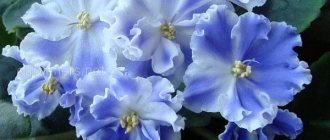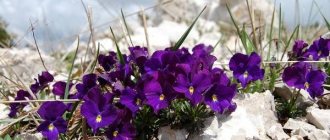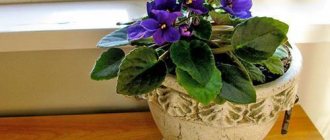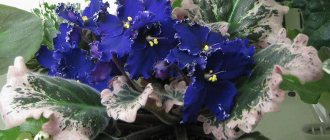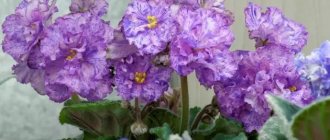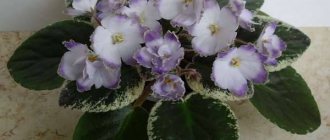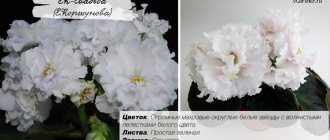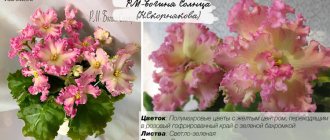Some time ago, Saintpaulia breeders became interested in the problem of reducing the overall outline of violets in order to save space on flower growers' shelves and window sills.
Issues of mini and microforms in breeding varieties began to occupy a special place in their developments . Violets of such special sizes can be placed much more compactly in home collections without losing:
- Their decorative silhouettes;
- And flexibility in relation to care activities.
And it turns out to be a little easier than their standard relatives.
Among the domestic masters of selection of miniature varieties of violets, Igor Milekhin can be distinguished with his line of exotic crumbs, stunning in diversity and enchantingness, which is one of the most numerous in the world.
His Saintpaulias of minimal silhouettes are of great interest to the global community of violet growers , as they allow you to create chic collections in a limited space.
Let's take a closer look and find out what the Balchug group of violet varieties looks like (I. Milekhin): Dream, Intuition, Mistral, Protégé, Yeti, Stay, My Precious, Dreamcatcher.
ATTENTION! Almost all varieties are suitable for cultivation even by novice gardeners.
Particularly interesting are violets from the group under the general name “Balchug”.
Violet Baltschug Intuition
Unusual violet Balchug Intuition.
The delicate variety of the 2010 selection represents the mini subspecies .
Description of the variety
Violet easily forms charming rosettes of miniature dimensions from even tiers of leaves using a mosaic principle.
The oval-shaped leaves are colored with summer greens and have:
- Smooth and shiny surface;
- Smooth, rolled edge;
- And light green venation.
Violet has oval leaves.
Semi-double flowers of large diameter make up a lush bouquet . The petals have a light pinkish tone, smoothly turning closer to the wavy contour into an intense pink color.
Sports
Violet is not noticed in sporting activities.
Specificity of growing in a room
Violet:
- Does not apply to whims;
- Develops quickly, without incident;
- It blooms a lot and in large bouquets.
Flowers of significant size look even larger on a small rosette and last a long time :
- Decorative;
- And freshness.
The color variety is very lush.
The disadvantages of the variety include :
- Hardening of leaves with age until they feel plastic - it is necessary to rejuvenate more often;
- Intolerance to bright light: the center becomes clogged, the lower leaves hug the flowerpot.
Reviews
Faina Vasilievna. “ I’ve never grown miniatures, but the violet “Baltschug Intuition” won my heart: a tiny rosette of lush greenery with a huge bouquet of pink “carnations.” Charming variety, put it on my wish list.”
Natalie. “ The Balchug Intuition variety has been growing for me for almost seven years. I consider it a godsend for not very experienced violet growers: it grows and blooms without quirks, its decorativeness is beyond praise.”
Useful video
Watch the video of how the Balchug Intuition violet blooms:
Features of transplanting Lyubasha violets
The root system of violets does not develop as intensively, so it requires regular replacement of the soil. It is advisable to replant once a year, but much depends on the composition of the substrate and the frequency of fertilizing. This process should be approached responsibly, without violating the transplantation technique and observing the requirements for container and nutrient substrate.
What should the soil be like?
The substrate for transplanting indoor violets can be purchased in specialized stores or prepared independently.
The substrate for annual transplantation of violets should be light and nutritious.
These plants love acidic soil, which should include:
- peat – 3 parts;
- leaf soil - 5 parts;
- coarse river sand – 1 part;
- sphagnum and charcoal - their share should not exceed 10% of the total mass of all components.
Once a year, the substrate should be additionally fed: in winter with a solution of humate, in spring and autumn - with liquid mineral fertilizers.
Planting container requirements
To plant and replant the Lyubasha violet, you need to choose a compact pot, since in a spacious container it will grow for a long time, and flowering will not come soon. A pot that is too small is also unacceptable: in it the root system will not be able to develop normally. For children and young rosettes, containers with a diameter of 5-6 cm are suitable, for adult specimens - up to 10-12 cm.
Interesting. Experienced flower growers advise choosing a pot whose diameter is three times smaller than the rosette of the flower.
A mandatory requirement for a container for transplantation is the presence of several drainage holes in the bottom for high-quality, uniform drainage of liquid.
Step-by-step instructions for transplantation
It is best to transplant violets in the spring months.
In autumn or winter, violets practically stop growing and blooming, so replanting during this period will have a bad effect on adaptation to a new place. It is advisable to replant plants in spring or early summer, then the flower will take root as quickly as possible in the new pot.
But even in this case, there is one “but”: violets do not like heat, so the weather during the transplantation period should be cloudy for at least a couple of days.
Replanting is carried out with a complete replacement of the soil, regardless of the frequency of fertilization. In any case, the soil is depleted and will not be able to supply the transplanted plant with the full range of useful substances.
Manipulations for planting violets have the following sequence:
- the flower is removed from the old pot, and the root system is cleared of soil;
- the plant is carefully inspected: dry flowers, rotten roots and yellowed leaves are removed;
- cut areas are treated with ground activated carbon;
- a drainage layer of expanded clay or polystyrene is laid out in a pre-prepared and washed container, and soil is poured on top;
- a violet is placed on it, the roots are carefully distributed and sprinkled with a layer of soil;
- a day later, the flower is watered and sent back to the windowsill.
Find out what kind of care the indoor violet Passion needs.
Read the description of violet Svetlana with reviews from flower growers.
Violet Balchug Mistral
Fascinating violet Balchug Mistral.
The mini subspecies variety has been known to flower growers since 2010.
Description of the variety
The violet conscientiously collects leaves into a rosette that is ideal in configuration and filling of tiers. Bush loves to break the boundaries of miniature dimensions.
The oval-elongated leaves differ:
- Lightly quilted surface;
- Minimal jagged edges;
- Clear graphics of veins;
- And the top side is painted in a rich tone of dark green.
The leaves of the variety are oval and elongated.
The reverse side of the plate is illuminated with pink highlights.
The flowers are bells of pure lilac-violet tones and have outlines that are too large for miniatures, visually appearing even larger due to the wavy structure of the petals . The flowers look like a tall bouquet due to persistent peduncles.
Sports
Saintpaulia sometimes forms sports with blue flowers.
Sport violet has a dark blue tint of flowers.
Nuances of content in the collection
The violet forms a bush on its own, but constantly tries to outgrow the varietal boundaries - to prevent these attempts, the plant should be planted in smaller flowerpots.
The list of positive qualities includes:
- Long-term preservation of decorative flowers;
- Large cap of considerable size corollas;
- Strong flower stalks;
- Ideal outlet.
Saintpaulia has a perfect and even rosette.
The variety is recommended for beginners due to its problem-free behavior .
Reviews
Alexander Ivanovich. “ I purchased the varietal violet “Baltschug Mistral” almost at the first exhibition, and since then we have been getting along peacefully: I take minimal care of it, it develops beautifully and blooms magnificently. I advise everyone who has little space to grow this variety.”
Violet Running on the Waves (T. Dadoyan)
Delicate violet running on the waves.
Violet "Running on the Waves" is a representative of the Gesneriaceae family of the Saintpaulia genus. The author of the variety is T. Dadoyan. The flowers are 2-3 times larger than those of other representatives of this genus.
The variety “Dark Night” is considered related. They differ only in the variety of colors:
- In Dark Night they turn red from the inside;
- And those of the Wave Runner are blue.
Violet Running on the Waves is often compared to the Dark Night variety.
They have a variety of colors . Vary from dark blue with white tints to pure blue.
Unusually, the edges look as if they were specially cut with small scissors to give a more expressive look. Reach a total of up to 8 cm in diameter.
Attention! The trunks are elongated, so they often fall on the foliage due to the large weight of the buds.
Violet Balchug Protégé
Exquisite violet Baltschug Protégé.
This exquisite variety represents miniature chimeras.
Description of the variety
Tiny violets, related in size to the mini subspecies, independently form even rosettes with a symmetrical distribution of leaf plates on tiers according to the compact principle of laying tiles.
The slightly long violet leaves are different :
- Quilted structure;
- A clear pattern of vein arrangement;
- Small, pointed teeth along the lateral edges;
- And painted with a dark green color.
Saintpaulia has a clear pattern on the leaves.
The underside of dense, fluffy leaves begins to acquire a reddish coating .
NOTABLE! The value of the variety lies in the coloring of the flowers according to the chimeric principle: the petals, colored depending on the specimen and the conditions of detention with transitions of pinkish-burgundy tones, each have a very wide, centrally located strip of white color.
The size of the flowers is quite large for a mini rosette, the number of petals corresponds to the semi-double type.
Sports
Violet is characterized by the stability of varietal categories; it does not form sports.
Specifics of room keeping
The variety simply gets used to the specific microclimate conditions of the room, develops quickly, caring for violets is not particularly difficult - classical maintenance methods.
Blooms a lot, for a long time, often. But the color of the corollas can vary depending on the conditions in which budding begins - flowers are able to change color intensity from flowering to flowering.
This Saintpaulia requires proper care.
ATTENTION! It will not be possible to propagate a chimeric variety using leaf cuttings - the signs of the chimera will completely disappear. You can get new bushes from the stepsons of the mother violet, from apical cuttings, or from individual peduncles.
Reviews
Sofia Mikhailovna. “ The Baltschug Protégé variety magically contains everything that I value in Saintpaulias: minimal size, huge flowers, dark, quilted foliage and chimeric coloring. But all the leaves had already been taken apart. I could hardly wait for the next exhibition and was first in line for my “protégé.”
Useful video
Find out in the video how to root the Baltschug Protégé violet:
Watch the video of how Saintpaulia Baltschug Protégé blooms:
Reproduction methods
The “Peach Shine” violet, like other representatives of this species, reproduces in several ways: by peduncle or leaves.
Reproduction by peduncles is used in order to preserve and transmit to the offspring a fancy color pattern.
So, to grow a violet in this way, you need to break out a healthy and strong peduncle, which has the most beautiful flowers, then lay it on a hard surface and cut off the lower part with a sharp blade. In this case, you need to leave one centimeter to the stipules. Buds and flowers must also be completely removed, leaving only stumps 3-5 mm high.
The resulting tree is what will be used to grow a new flower. The cuts must be thoroughly powdered with charcoal, which will have a disinfecting effect.
The success of the event will depend on watering. It should be minimal. With proper manipulation, after a while small leaves will appear in the axils of the stipules - future rosettes. The timing of the appearance of small rosettes always varies. They may appear a month and a half after planting or much later.
For propagation by cuttings, healthy, well-formed leaves of medium size are used. The lowest leaves of young plants are cut off. For older people - from the second row from the bottom. Young leaves, which are located closer to the center of the rosette, take root faster, but can produce weakened offspring. And those leaves that are old or are already beginning to turn yellow will slowly form roots and, most likely, will die before they even have time to form young plants.
For cuttings, the water should be clean and soft; it is best to use distilled or melt water. To root cut cuttings in water, it is best to use medicine and mustard jars. In crystal glassware, not a single variety produces roots.
The water is not changed during rooting, but only added as it evaporates. If the end of the petiole rots, it must be cut off and moved to another vessel with distilled water. You can also try rooting it in sphagnum moss or soil.
The leaves of violets, which were previously rooted in water and then planted in a box, do not need to be covered with film. A microclimate with high air humidity in the box is created by the damp surface of the earth. The box with planted cuttings should be placed near a window or under a fluorescent lamp.
Violet Balchug Yeti
Mysterious violet Balchug Yeti.
Touching Saintpaulia belongs to the miniature varieties.
Description of the variety
The violet consists of tiers of leaves tightly arranged in a mosaic pattern on short petioles, which ultimately forms a beautiful rosette of a symmetrical structure.
Leaves of medium size for mini size have:
- Smooth contours with barely visible notches;
- Elongated – heart-shaped configuration;
- Quilted surface;
- And the coloring is in the tone of summer green.
The variety has large flowers.
Chic bouquets of violets consist of:
- Large flowers semi-double;
- And simple filling with petals.
The main white color of the corollas successfully emphasizes:
- Blue tint of the core;
- And the filigree blue and lilac edging of the petals.
Sports
Violet sports with enviable frequency, forming caps consisting of :
- Flowers with lilac streaks over the entire surface of the petals;
Lilac sport variety. - The corollas are even purple in color.
Purple violet sport.
Difficulty of cultivation in collections
The variety is easy to maintain and has only positive characteristics :
- Ideal socket;
- Greater frequency and volume of flowering;
- Cap type of formation of peduncles from the first bud formation.
The violet in question blooms in a cap type.
CAREFULLY! When flowering in conditions of elevated temperature, the amount of blue color may gradually increase; with insufficient lighting, a loose rosette is obtained.
Reviews
Yulia Vladimirovna. “ When growing the Baltschug Yeti violet, the main thing is to remember the influence of temperature indicators on the color of the flowers. The hotter the room, the less white color will remain on the petals. But the rest is just classic care for Saintpaulias.”
Description of the variety LE-Madame Clicquot
The Madame Clicquot violet was first introduced by Vinnytsia breeder Elena Lebetskaya in 2015. The variety is relatively new, but has already won the love of collectors with its compact size and amazingly beautiful flowers. Saintpaulia got its name for a reason, because Madame Clicquot is also a world famous brand of champagne.
The variety LE-Madame Clicquot is indicative of its exemplary flowering - double and semi-double corrugated stars open gradually. The color of the flower is heterogeneous - yellow rays emerge from the center, which gradually fill almost the entire flower as it opens. The size of fully blossomed buds can reach 6 centimeters, which, if there are several flower stalks, is quite enough for a beautiful bouquet of flowering.
Madame Clicquot belongs to the standards, but it is quite possible to grow it compact without making much effort. It is enough to plant the rosette in a small pot to keep the size of the plant within the small standard. The leaf of the variety is emerald green, wavy, but unfolds independently without any problems, without clogging the center or spoiling the symmetry.
Another advantage of the LE Madame Clicquot violet is its long flowering, during which the buds retain their original freshness and do not rust, like other yellow-flowered varieties. Flowers can last up to 3 weeks, while their middle does not turn brown, the yellow color lasts well and remains as rich as immediately after blooming. The first opened and new buds look the same. Madame Clicquot's flower stalks are strong, hold large buds well and do not lean on the rosette.
The variety is easy to propagate and produces babies quite quickly. Madame Clicquot may go into sports or give birth to athletic offspring, but the future color of the buds can be determined in advance at a young age - on plants with blue flashes on the flowers, the leaves will be pigmented.
Violet Balchug Stay
Dear violet Balchug Stay.
The pastel variety has been found in collections since 2010 .
Description of the variety
Saintpaulia itself forms even bushes with perfect symmetry and a fairly high degree of fullness. The leaves on elongated petioles are slightly tucked down, forming a voluminous hemispherical rosette. According to the numerical gradation of dimensions, the variety falls into semi-miniature varieties.
Oval leaves differ:
- A clearly visible emerald veining pattern;
- Quilted surface;
- Small, smoothly rounded edge teeth;
- And the tonality of dark green.
The variety has a bed shade of flowers.
The bush blooms with a cap of simple flowers, painted in pastel shades of pink with coral splashes. Darker markings are visible at the base of the petals. The edges of each petal are decorated with elegant frilly braid.
Sports
After several flowerings it can develop into abundant fringe and a more coral tone.
Sport violets in a coral shade.
Peculiarities
Saintpaulia is rarely found in collections, although it shows such positive qualities as:
- Ideal outlines;
- Growing up fast;
- Abundance of buds.
The violet is growing quickly.
The variety does not like to form many children. Flowers acquire a reddish hue as they age.
Reviews
Ilya Ilyich. “I respect the selection of I. Milekhin - magnificent miniatures for every taste. In the Balchugov line, I especially highlight “B. Stay" for the delicate tones and long-lasting flowers."
Common diseases and pests of violets
Violets of the Lyubasha variety are most susceptible to infectious diseases caused by fungi, bacteria and viruses. The danger is that if the diseased specimen is not removed in a timely manner, the remaining plants quickly begin to become infected.
Violet Lyubasha may become ill with a fungal or infectious disease.
Fusarium
This disease is characterized by rotting of the root system and petioles of the plant. The leaves acquire a brownish tint and begin to fall off, and the darkened roots are easily separated from the ground.
Fungicides are used to treat affected violets, and rotten parts and dried flowers are eliminated. For preventive purposes, plants should be watered with Fundazol solution once every two months.
Powdery mildew
This disease is a consequence of insufficient lighting, high humidity, low room temperature, unsanitary conditions on shelves with pots, or an excess of nitrogen and a deficiency of potassium and phosphorus in the soil.
The disease manifests itself as a white coating on the stems, peduncles and leaves. Often the leaves appear dusty, but even with thorough washing, the whitish stains do not disappear.
Treatment of powdery mildew of violets comes down to a single spraying with Fundazol or Benlat. If there is no result, the procedure is repeated after 10 days.
Late blight
A dangerous fungal disease that can cause rotting of the plant's root collar, causing the leaves to become covered with brown spots. The diseased flower is completely destroyed and the pot is disinfected. To prevent the disease, you should flavor the soil with superphosphate and monitor the humidity in the room.
With late blight, brown and brown spots appear on violet leaves.
Gray rot
Another fungal disease caused by botrytis fungi. A characteristic sign is the presence of a brown-gray fluffy coating on the leaves, flowers and petioles, as well as rotting of plant tissues.
The disease quickly leads to death, so the affected parts must be immediately removed and the plant itself treated with fungicides. Rotten plants should be thrown away along with the earthen ball.
Chervetsy
Deformation of the leaves, the appearance of red or brown spots are signs of an attack by scale insects. The drugs Fitoverm, Actellik or Aktara help fight them. If damaged by a soil mealybug, it is enough to shake off the infected soil from the roots and replant the flower in a fresh substrate.
Aphid
These green insects love to leave marks on buds, flowers and flower stalks. Their negative impact will cause defective flowering and deformation of flowers. The drugs Mospilan and Actellik have proven themselves to be effective against aphids.
Ticks
There are many varieties of these pests: some leave red spots on the leaves and deform them, others cause depressed brown spots, and still others cause yellow spots and grayish dust on the leaves. But products such as Akarin, Fitoverm and Actellik are effective against all types of ticks.
Violet Balchug My Prelest
Charming violet Balchug My Prelest.
Delicate miniature with a lush head of flowers .
Description of the variety
A feature of the miniature variety is the formation of a rosette with large gaps between the leaf plates - this is the result of the presence of long petioles on the leaves. It is very rare for bushes to be brought into ideal shape.
The leaves are different:
- Small dimensions;
- The tonality of summer greens;
- Smooth surface;
- And a straight edge line.
The underside has a reddish tint with a silver coating .
Violet has smooth leaves.
Flowers are formed of large diameters , their shape is somewhere between:
- A simple “star”;
- And a bell.
The tonality of the corollas is expressed by a mixture :
- White color with cream;
- And pink tints, more pronounced at the edges of the petals.
Sports
The plant has not been used for sporting.
Features of cultivation
The variety blooms very quickly.
The variety is not very picky, although there are some nuances . It develops and blooms at an accelerated pace. From the first flowering it has strong peduncles.
When growing a variety, you should carefully monitor the microclimate:
- A small amount of light gives the rosette an indistinct shape;
- Excessive lighting can cause leaves to curl.
Reviews
Olga Yanovna. “ The variety “Balchug My Prelest” is one of the most expensive Saintpaulias in this line in terms of care - it is necessary to set the light, and you have to tinker with the socket. But the decorativeness is worth it!”
Caring for a plant at home
Care is an important and integral component of the development of each flower, as well as its viability. And this variety is no exception. For him, as well as for others, the following are important:
- Watering;
- Lighting;
- Fertilizers (feeding);
- Temperature, air humidity, and much more.
Conditions of detention
The basis for keeping violets has always been:
- Lighting;
- Air temperature;
- And also abundant watering;
- Fertilizer;
- Suitable air humidity;
- And regular plant hygiene measures.
Proper watering and fertilizing
If we talk about proper watering for Saintpaulias, then, first of all, it depends on what time the watering is done:
- If we are talking about the spring-summer period, then watering should be quite frequent - at least 1-2 times a week;
- But in winter or autumn, the frequency of watering should not exceed 1-2 times a month.
ATTENTION! In addition to regular watering, flower growers should also focus on the degree of soil moisture in order to prevent overmoistening of the substrate and further flower diseases.
This variety best accepts moisture obtained from:
- Top watering;
- Or watering on a wick.
You can water Saintpaulias using a wick.
It is best to fertilize violets with Mister Color. Saintpaulia." Apply fertilizers no more than 1-2 times a month, alternating them with regular watering.
Also, in addition to fertilizing, violets can be fed with the following preparations:
- "Epin";
- "Kornevin".
As fertilizers, or their bases, you can use:
- Ethanol;
- Ash, and so on.
You can read more about this in the article “Different fertilizers for violets.”
Lighting and temperature
For Saintpaulias, diffused sunlight is optimal. Direct sunlight contributes to:
- Burns on the leaves;
- And also drying out of flower stalks.
Although, in some cases, direct sunlight is considered acceptable during specially designated hours when the sun is not yet bright enough. Most often this is from the beginning of daylight until 10 am , and from 16.00 until the end of daylight.
The air temperature for Saintpaulia should be from 20 to 25 degrees . In the warm season, it is allowed to open the windows in the evening, thereby reducing the temperature to + 18 degrees. This ensures air circulation in the room, which promotes the active development of violets. The minimum air temperature permissible for violets can reach +10 degrees.
Of course, a sharp decrease or increase in temperature is extremely undesirable, but in the event of a sharp change in temperature, low temperatures are safer than high ones.
The fact is that when the temperature drops below + 10, the violet simply stops its development, while a significant excess of the temperature norm is fraught with drying out of the flower stalks, as well as the death of the entire plant.
Air humidity
Violets prefer moist air.
Excessive moisture contributes to rotting of the plant’s root system and is also the cause of :
- Development of many diseases;
- And parasite infestations.
The most dangerous and most difficult to identify are:
- Whitefly;
- Shchitovka;
- Mealybug.
What soil do you prefer at home?
Violets accept purchased soil for Saintpaulia quite well. But if a gardener needs to know for sure that the soil is of high quality and enriched with vitamins and microelements, it is best to prepare it yourself.
Most often, to prepare an earthen mixture at home, the following ingredients are needed in equal proportions:
- Black soil;
- Tree moss;
- Sand;
- Tree bark;
- Drainage.
Pruning and hygiene
In order for Saintpaulias to feel good and not stop developing, they need to periodically carry out hygiene procedures . Including:
- Trim dry leaves and dried flower stalks;
- And also replant them regularly.
The flower pot, however, should not be too large, since the flower must take root tightly . Replanting must be done at least once a year, this will help prevent the flower from becoming infected with parasites.
It is necessary to remove dry and limp leaves from Saintpaulia.
ADVICE! If it is necessary to propagate violets with leaves, the cut sites must be treated with crushed coal or cinnamon for the purpose of disinfection.
Reproduction methods
There are three main ways to propagate Saintpaulia:
- Leaf;
- Cuttings;
- Stepsons.
In this particular case, it is best to propagate the variety by leaves, thus preserving the species characteristics of the variety.
Rules for transplantation and reproduction
Saintpaulias are most often propagated by leaves . The seedling is pruned so that the cutting remains long, at least 5 centimeters. The cut site is disinfected:
- Cinnamon;
- Or powder from crushed coal.
The seedling is placed in a glass of water for 5-7 days , after which it is planted in a small flower pot. The first watering is allowed a month after transplanting the young plant.
Violet Balchug Dreamcatcher
Simple violet Balchug Dreamcatcher.
Miniature with an elegant range of colors.
Description of the variety
The rosette is formed in full accordance with the standard dimensions of the miniatures . The bushes have:
- Harmonious silhouette;
- Good density of leaves;
- And the principle of “reverse mosaic” when distributing them into tiers.
The leaves are different:
- Small size;
- Shaped like decorative hearts;
- Smooth side edge structure;
- And the color of spring greenery.
The leaves are a shade of spring green.
The voluminous bells of the corollas on elongated peduncles amaze:
- Almost transparent structure;
- Slightly wavy edge;
- And a color scheme of transitions of lilac shades with a smoky coating.
Sports
After rejuvenation, Violet can become a sports chimera.
After rejuvenation, the sport may exhibit chimeric characteristics.
It can bloom with purple flowers with a white border.
Purple-white sport violet.
Room maintenance techniques
Saintpaulia belongs to varieties with:
- Completely easy to care for;
- And absolutely non-capricious behavior regarding content.
It puts out a beautiful rosette itself , grows quickly, blooms for a long time and has many flowers.
The variety in question blooms for a long time.
The florist can only:
- Follow a standard set of care regimens;
- And admire the magnificent decorativeness.
Reviews
Zhanna Antonovna. “ I really love delicate miniatures, but the violet “Baltschug Dreamcatcher” is still in my future - no luck with the leaves, the third time the grown-up child blooms with sports.”
Features of flowering, growth and reproduction
This violet blooms beautifully. And elegant.
Development at home
Good conditions ensure intensive growth of leaves, formation of a good rosette and buds. After purchasing any violet, you want its development and the appearance of flowers as quickly as possible. And a lot depends on you.
The variety itself can bring surprises. The first flowering may be inexpressive. But the ones that follow are impressive.
How long does it take to grow an adult plant?
It will take a lot of time to grow adult plants. It depends on many things. And concepts.
Flower growers consider plants that are beginning to bloom to be mature. Where to start counting:
- From the moment of sowing the seeds - up to a year;
- From the beginning of rooting of the cuttings after 7-10 months.
How are varietal characteristics transmitted?
The variety reproduces well:
- Many collectors prefer propagation by leaf. Of the varieties offered for purchase, the most common is a leaf with a cutting; Pay attention to the violet leaves at the exhibitions. They have already been ordered and scheduled for post-exhibition sale;
- Pick leaves from the middle of the bush. And absolutely healthy. Leaves take root: In water;
- In a peat tablet;
- Using sphagnum moss and vermiculite;
- In the ground.
- Rooting the peduncle . To preserve the best qualities of unique varieties. Valuable to you. Cut strong specimens;
- They are not often propagated by seeds For a long time. There are fewer guarantees for receiving the same variety.
Important! Use sharp and treated tools!
Flowering in hot and cool conditions
Flower growers like the stability of the Tsarskaya Osoba violet:
- The flowers retain their beautiful and rich color for a long time;
- Even with significant changes in room temperature.
What do flower stalks look like?
Strong and low . They hold 2-3 flowers confidently. They are not always even visible on this variety. Due to its huge size.
Is it possible to achieve cap flowering?
Many buds on strong peduncles allow you to form a beautiful head . What many violet lovers strive for.
This cap delights many violet lovers.
Bud lifespan
There are few complaints about the flowering variety. More positive reviews. Blooms profusely and amicably. They also maintain their color for a long time.
The intervals between flowering may vary. But no more than 2-3 months.
Growing problems
Improper maintenance conditions lead to the fact that the violet begins to hurt.
All violet problems are associated with violation of the rules for caring for it. Most often, the plant suffers from root rot. High air humidity, low temperature, waterlogging of the soil are the main enemies of this plant.
Often the rotting process starts with prolonged dryness of the soil, followed by abundant moisture. Overdried horses cannot immediately absorb water and begin to rot.
A sign of trouble with the roots is wilting or yellowing of the leaves, their gradual death. Root rotting may additionally be accompanied by fungal diseases: fusarium, late blight, rust, powdery mildew. In this case, a gray or white coating, red or brown spots appear on the leaves.
[adsp-pro-7]
When the first signs of disease are detected, the following measures must be urgently taken:
- Remove all affected leaves.
- Remove the rosette from the pot, free it from the old soil, cut off the rotten parts.
- Plant the violet in a new pot, filling it with fresh soil.
- Treat the outlet with an antifungal agent.
The violet may also suffer from pests that enter the apartment with a new plant, cut flowers, or soil. Most often, violets suffer from aphids, thrips, mites, scale insects, root-knot nematodes, and scale insects. For prevention and treatment, the drugs Alatar, Aktara, Actellik, etc. are used.
Reviews from flower growers about the variety
Irina. Several years ago I became the happy owner of Lyubasha violets. When the flower bloomed, I was completely delighted: delicate pink color, white and light green border, the flowers themselves were like voluminous balls. The variety blooms profusely, is unpretentious in care, and is one of the first to bloom. By the way, it was after Lyubasha that I became interested in growing violets.
Svetlana. Once upon a time I foolishly got rid of these violets. When, during the first flowering, I did not see those very gorgeous pink flowers, I was disappointed and hastened to give the plant to a friend. Some time later I saw this beauty during its second flowering period and was simply amazed. Now I am growing these violets myself.
We offer you to watch a video in which a florist shows the Lyubasha violet and talks about it.
Necessary conditions of detention
It is preferable to grow passion violet on a shelf under artificial lighting. When kept on a window, the leaves hug the pot tightly, exposing the center of the rosette. Daylight hours for violets are 12-13 hours. In winter - at least 10 hours.
The temperature of violet content is 20-24 degrees. At elevated temperatures, the flowers float and lose their spectacular two-tone color, which is why you can often find monochromatic photos and descriptions of Passion variety violets online. A decrease in temperature to 12-13 degrees is critical for the plant. Under such conditions, the risk of violet infection with fungal diseases increases.
Comfortable air humidity for keeping violets is 50-65%. High humidity leads to the development of gray rot and other diseases. When humidity levels are low, the leaves begin to dry out and buds may begin to drop.
Over-humidification can be prevented by ventilating the room. During ventilation, it is important to ensure that the violet is not exposed to a draft. You can increase the humidity level by placing a pot of violets on a tray of water. To prevent the bottom of the pot from touching the water, a layer of expanded clay is poured into the tray.
Violet Passion is best grown not on a window, but under lamps.
Important. You cannot spray violet leaves to increase humidity: stains and yellow spots remain on the leaves.


